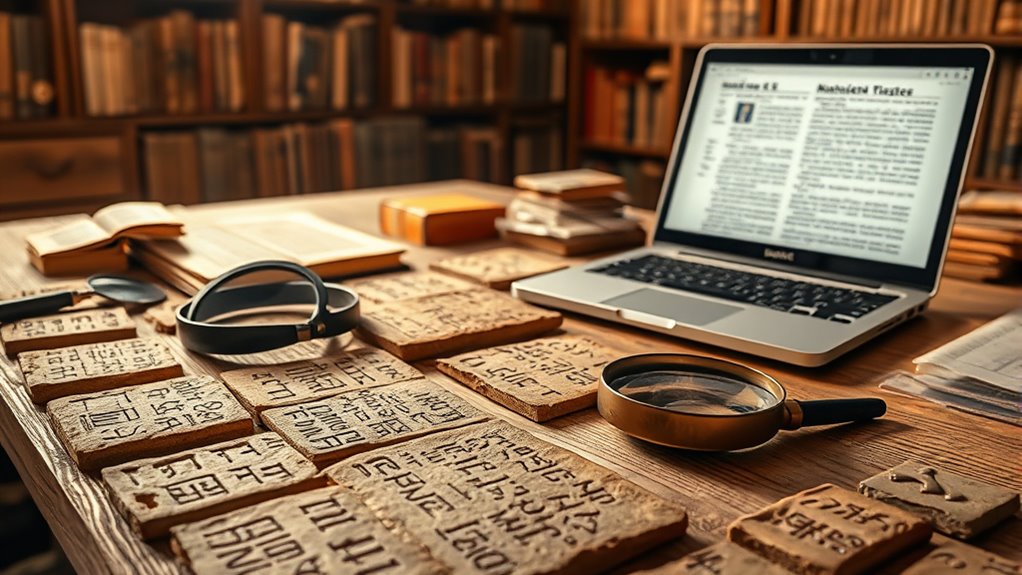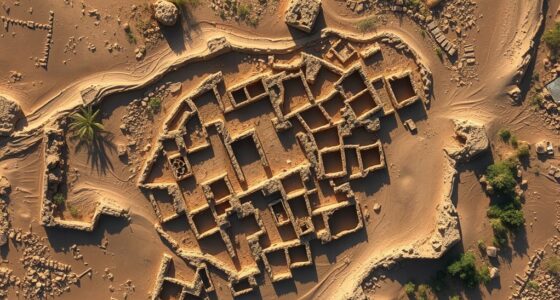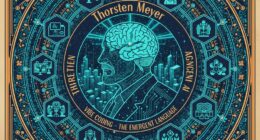An amateur named Michael Ventris cracked Linear B by analyzing patterns in the symbols, hypothesizing that it was related to Greek. Using his intuitive approach, he identified phonetic values and recognized the script as an early form of Greek, revealing inventories, names, and economic records. His breakthrough transformed our understanding of the Mycenaean civilization and its complexity. If you want to discover more about how this breakthrough happened, keep exploring the fascinating story behind it.
Key Takeaways
- Michael Ventris, an amateur architect and linguist, hypothesized Linear B was related to Greek based on pattern analysis.
- He identified consistent phonetic values for symbols, revealing the script’s underlying language.
- Ventris’s comparative analysis linked Linear B symbols to known Greek phonetics, leading to successful decoding.
- His breakthrough demonstrated that dedicated, self-taught efforts could decipher complex ancient scripts.
- Deciphering Linear B transformed understanding of Mycenaean society, showing it was an early Greek civilization.

Have you ever wondered how ancient civilizations recorded their history and administration? The answer lies in their unique writing systems, which serve as vital clues to understanding their culture, governance, and daily life. Linear B, in particular, is a fascinating example. This script was used by the Mycenaean civilization in Greece during the late Bronze Age, around 1450 to 1200 BCE. Unlike the more famous Linear A, which remains undeciphered, Linear B was a syllabic script that recorded administrative details, inventories, and religious texts. Its decipherment opened a window into a civilization long vanished, revealing details about their economy, social structure, and religious practices. The writing system’s archaeological significance cannot be overstated; it transformed what we knew about ancient Greece and helped establish the importance of written records in understanding history.
You might not realize that deciphering Linear B was initially a formidable challenge. The script had been discovered on clay tablets in archaeological sites like Knossos and Pylos, but no one could interpret their meaning for decades. It was an amateur, Michael Ventris, who took a bold step. Ventris, an architect and self-taught linguist, dedicated himself to cracking the code. His approach involved meticulous analysis of the symbols, comparing them with known languages and patterns. He hypothesized that Linear B might be related to Greek, and his intuition proved correct. When he identified consistent phonetic values for the symbols, the puzzle began to unravel. His breakthrough demonstrated that the script was a form of early Greek, and that the tablets recorded inventories, names, and possibly even economic transactions. Deciphering ancient scripts played a crucial role in this achievement.
Decoding Linear B didn’t just satisfy academic curiosity; it redefined our understanding of Mycenaean civilization. The tablets revealed a complex society with organized administration, an advanced economy, and religious institutions. They showed how these ancient people structured their society and managed resources, providing a clearer picture than any previous archaeological evidence alone. The script’s archaeological significance lies in its ability to connect material remains with written records, giving voice to a civilization that otherwise would be lost to time. Thanks to Ventris’s work, you now understand that deciphering an ancient writing system isn’t just about solving puzzles—it’s about *accessing* the stories of our ancestors, stories etched into clay tablets that continue to speak across millennia.
Frequently Asked Questions
What Tools Did the Amateur Use to Analyze Linear B?
You used digital tools to analyze Linear B, which made the process more efficient. By applying comparative analysis, you examined similarities between known scripts and Linear B, helping you identify patterns and symbols. These tools allowed you to organize data quickly and test hypotheses effectively. Your approach combined modern technology with traditional analysis techniques, ultimately enabling you to crack the ancient script without formal training but through careful, systematic investigation.
How Long Did It Take to Decode the Script Completely?
Ever wonder how long it takes to fully decode an ancient script? You’d see the timeline milestones marked by breakthroughs amid decoding challenges, gradually revealing the language’s secrets. For Linear B, it took years of meticulous work, patience, and persistence. The process involved overcoming complex symbols and gaps in knowledge, but each milestone brought you closer to understanding the script’s full meaning, transforming your view of ancient civilizations step by step.
Were There Any Previous Failed Attempts at Deciphering Linear B?
You should know that there were definitely decipherment challenges and archaeological skepticism when trying to decode Linear B. Early attempts faced many failures, as scholars doubted whether the script could be cracked at all. It wasn’t until expert efforts and advances in understanding that progress was made. Despite setbacks, persistent researchers gradually overcame these challenges, ultimately revealing the script’s meaning and unlatching valuable insights into ancient Mycenaean civilization.
Did the Amateur Collaborate With Professional Linguists or Archaeologists?
You might wonder if the amateur collaborated with professionals. Despite community skepticism, the amateur did seek scholarly collaboration, which helped validate their findings. Their work sparked debate among archaeologists and linguists, emphasizing the importance of expert input. While initial doubts existed, the collaboration ultimately contributed to a broader understanding of Linear B, demonstrating that even amateurs can make significant contributions when they work with the scholarly community.
How Has This Discovery Impacted Understanding of Ancient Mycenaean Society?
You might think this discovery reshaped our understanding of ancient Mycenaean society, revealing intricate trading networks and a clear social hierarchy. In reality, it confirms that Mycenaeans engaged in extensive trade and had a structured society. This breakthrough helps archaeologists piece together economic and social dynamics, showing how the written records reflect their complex interactions and hierarchy, deepening our appreciation of their sophisticated civilization.
Conclusion
Now that you’ve seen how an amateur cracked Linear B, it’s clear that persistence can break down even the toughest barriers. Sometimes, it’s the outsider who sees what others miss and proves that fortune favors the brave. Don’t underestimate the power of curiosity and determination—they can turn a long shot into a breakthrough. Remember, the early bird catches the worm, so keep pushing forward; your breakthrough might be just around the corner.









